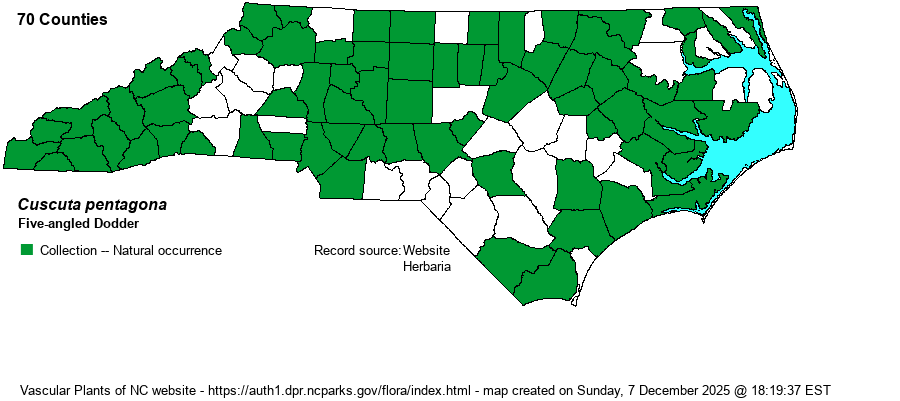| Author | Engelmann | |
| Distribution | Statewide, and probably found in all 100 counties, though seemingly scarce in the Sandhills region (with a collection from Cumberland County the only one within this sizable region).
This is a species occurring nearly all across the U.S., from MA west to WA, and south to southern FL and AZ. | |
| Abundance | Frequent to common throughout, other than rare to uncommon (apparently) in the Sandhills region. | |
| Habitat | This species occurs in a great array of open and usually disturbed habitats, such as roadsides, weedy fields, and other similar places. It climbs over a variety of hosts, mainly herbaceous ones. | |
| Phenology | Blooms from June to frost, and fruits shortly after flowering. | |
| Identification | See the Taxonomic Comments. The description from Gleason (1952): "Flowers 1.5-2 mm. long, short-pediceled in loose clusters. Calyx about as long as the corolla-tube, its lobes very broadly ovate or depressed, often broader than long. Corolla-lobes usually spreading, about equaling the broad tube, the acute tips often inflexed." That reference included C. campestris within this species, and thus Weakley (2018) separates these two similar species, as follows: C. pentagona -- Flowers 0.9-2.5 mm long; calyx lobes strongly overlapping and forming definite angles at the sinunes, thus the flower strongly 4-5-angled"; versus C. campestris -- "Flowers 1.5-3.0 mm long, at least some exceeding 2.5 mm long; calyx lobes not overlapping at the base in older flowers, and therefore the flowers not pronouncedly 5-angled". | |
| Taxonomic Comments | Some older references included C. campestris within C. pentagona.
The species of Cuscuta all share a few similar features, and they are difficult to separate except by mostly small characters, best seen with a hand lens or microscope. Each is a parasitic vine, lacking roots or true leaves, and nearly all are orange or yellow in color, twining up its host plant with the use of tiny aerial "roots". The small white flowers are in clusters along the stem. These plants should be quite familiar as a group, often presenting a tangled mass of orange vines growing over other plants. See Weakley (2018) or other references for keys to assist in identification. | |
| Other Common Name(s) | Field Dodder (used mainly for C. campestris) | |
| State Rank | [S5] | |
| Global Rank | G5 | |
| State Status | | |
| US Status | | |
| USACE-agcp | | |
| USACE-emp | | |

